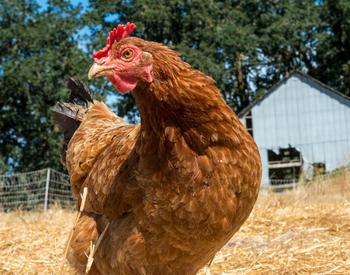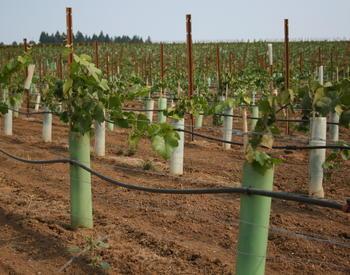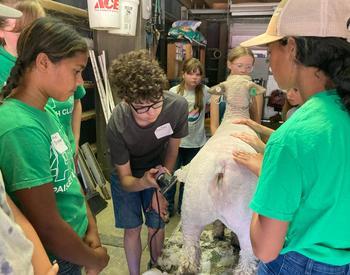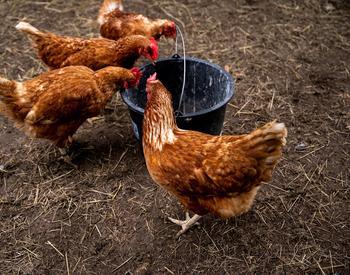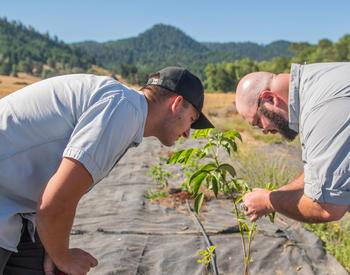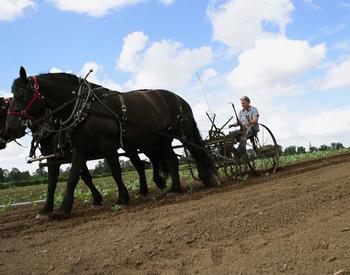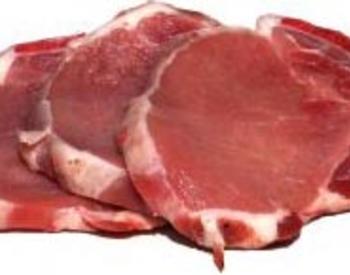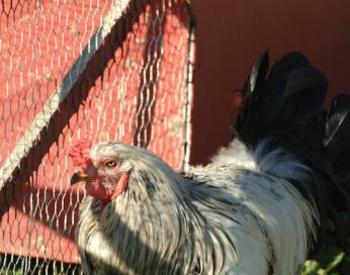Farmers and ranchers in Oregon raise and sell livestock and poultry for a variety of local and regional markets. Processing is a necessary but often complex link in the chain connecting farms to consumers. Here are the basic federal and state laws and regulations that apply to meat and poultry processing.
Federal law requires that meat and poultry sold for human food be processed at a federally inspected facility. Some states have cooperative inspection programs that are equal to federal inspection and are overseen by U.S. Department of Agriculture, but Oregon does not. The federal law allows some limited sales of uninspected meat and poultry, but Oregon law requires that to be sold as food, meat and poultry species must be processed in a state-approved and state-licensed facility.
What does inspected mean?
At USDA-inspected slaughter facilities, each animal is inspected before and after slaughter by an employee of the USDA Food Safety and Inspection Service. For USDA-inspected processors that do not slaughter, the inspection service employee visits at least daily to ensure processors follow proper food-safety procedures. These are both “continuous inspection.”
The Oregon Department of Agriculture licenses all processors, both USDA-inspected and exempt, and inspects all “exempt” facilities that are not “continuously inspected” by USDA. But ODA inspects the facility, not the animals. USDA inspects the health and physical integrity of animals at the time of slaughter. Oregon does not inspect the health and physical integrity of privately owned animals, because they are private property and not for sale. ODA inspection, typically annual, ensures compliance with construction, sanitation, liquid and solid waste disposal, and animal theft regulations.
Amenable vs. voluntary species
USDA inspection is required for “amenable” red meat and poultry species — cattle, hogs, sheep, goats, chickens, turkeys, ducks, geese, guineas and ratites (ostrich, rhea, emu).
Inspection is “voluntary” for other red meat and poultry species — rabbits, bison, domesticated deer, and domesticated quail, squab, pheasant and migratory waterfowl. Domesticated elk are considered “voluntary” by USDA, but in Oregon, they must be processed at a USDA-inspected plant.
For example, bison slaughtered and processed by a state-licensed, custom-exempt plant or mobile slaughter truck could be sold at a farmers market, to a restaurant or to a retail store both interstate and intrastate. But some buyers — retailers, in particular — may elect to buy only USDA-inspected meat.
Exemptions: when a federal inspection is not required
Retail exempt processing
Retail establishments, such as grocery stores, may process meat to sell at their own retail storefront and one other store with the same owner as long as the meat comes from animals slaughtered under federal inspection. A retail-exempt processor can also wholesale a limited amount of product to hotel, restaurant or institutional customers as long as the product hasn’t been cooked, cured, smoked, rendered or refined. Many small, custom-exempt processors also have a meat counter under the retail exemption.
Retail-exempt wholesaling is limited to 25% of the dollar value of the processor's total sales or a certain dollar amount per calendar year, whichever is less. The dollar limitations are adjusted by the federal food safety and inspection service annually and announced in the Federal Register: for 2016, they were $79,200 for red meat or other meat products and $58,200 for poultry products. Search the Federal Register for “Retail Exemptions Adjusted Dollar Limitations” for annual adjustments, typically announced in the spring.
Retail-exempt processors cannot sell to other retail markets or to wholesalers or distributors. Retail-exempt processors are subject to periodic, risk-based inspection by federal inspectors or state authorities.
Stationary custom-exempt slaughter and processing
A custom-exempt plant may only slaughter and process livestock for the exclusive use of the owners of the livestock or poultry. Like retail-exempt plants, these facilities are subject to periodic risk-based inspection by the federal inspection service and routinely inspected by state authorities.
Livestock sold “on the hoof” to individual buyers for their own household use can be slaughtered and processed at custom-exempt facilities. “Voluntary” species like bison may be processed here and sold retail, wholesale and interstate.
Poultry exemptions
Federal law contains seven exemptions to the inspection requirement for poultry. Different states treat poultry exemptions differently. In Oregon, small-scale producers have a few processing options. Under all of these options, the poultry must be sold within Oregon.
Poultry producers may each process up to 20,000 birds per year that they have raised themselves in a state-licensed facility that meets state sanitation requirements. Contact the Oregon agriculture department for requirements for poultry or rabbit processing establishments.
If a producer operates under the Small Enterprise Exemption (slaughter and cut-up only; also limited to 20,000 birds per year), they may purchase live birds raised by other producers, process them, and sell those birds back to the producers, who can then act as distributors.
Federal and Oregon laws allow multiple producers to use the same mobile poultry processing unit to each process up to 20,000 birds of their own raising, on their own farms. The unit must meet state sanitation requirements but with some variation because it is mobile.
In 2011, the Oregon Legislature passed the “Poultry Bill,” which mirrors the federal 1,000-bird exemption and allows a producer to process and sell up to 1,000 poultry per year direct to consumers without being a state-licensed processor. The poultry must be sold at the farm where it was raised and processed; no off-farm sales are allowed. The law allows off-farm sales, but only if the processing is done in a facility that could meet licensing requirements, even though the purchase of a license is not required. However, if your facility can be licensed, why not pay the license fee and be able to process up to 20,000 birds per year, not just 1,000? See the rules for this exemption, including recordkeeping and labeling.
The OSU Small Farms Program guide to best practices for food safety and sanitation during open-air poultry slaughter, and labeling requirements for this exemption is available online.
This law and the relevant Oregon Administrative Rules do not exempt producers from zoning laws and rules. However, in 2013, the Oregon legislature added the slaughtering, processing and selling of up to 1,000 poultry as an outright permitted non-farm use, subject to specified limits, in areas zoned for exclusive farm use. It is still prudent to investigate potential limitations in your location before starting a poultry business.
"On the hoof" Or "locker meat" sales
Rather than sell meat cuts, some livestock producers sell live animals “on the hoof,” which customers, as the new owners of the animal, can then have processed at a “custom-exempt,” state-licensed facility. Producers can sell a whole animal or shares: for example, a farmer sells one live steer to four people, each of whom gets a one-fourth share of the meat from that steer.
A “custom-exempt” plant may slaughter and process livestock only for the exclusive use of the owners. Some custom-exempt processors also have a mobile slaughter truck for on-farm slaughter, and some mobile slaughter trucks operate independently and bring carcasses to a custom-exempt processor. Unless a mobile slaughter unit is USDA-inspected (as of this writing, there are no inspected mobile slaughter units in Oregon), it cannot be used to slaughter and transport to a USDA processing facility.
Federal and state rules for on-hoof sales are explained in “Frequently asked questions about using custom-exempt slaughter and processing facilities in Oregon for beef, pork, lamb, and goat,” also available on the OSU Small Farms website.
Building and sanitation requirements for processing facilities in Oregon
In Oregon, livestock slaughter and processing facilities must be constructed with impermeable and easily cleanable floors and walls, floors sloped to drains, tight-fitting doors and windows, and other construction requirements generally mandated for the food-processing industry.
All processing facilities — small or large — must comply with Oregon Administrative Rules governing construction, sanitation and maintenance of such facilities.
The main rules you’ll need to follow are found in OAR Chapter 603 (Department of Agriculture), in two divisions: Division 25, “Food Establishment Standards and Standards for Retail Food Service Activities,” and Division 28, “Meat Products and Establishments.”
All the rules below start with “603” for the chapter; those with “025” in the middle are from Division 25, and those with “028” are from Division 28. Each division begins with definitions; specific rules are in numerical order.
- Division 25, “Food Establishment Standards and Standards for Retail Food Service Activities”
- Division 28, “Meat Products and Establishments”
- OAR 603-028-0100, “Sanitation, Maintenance, and Construction,” requires that all meat establishments comply with:
- OAR 603-025-0020, “General Standards of Food Establishment Construction and Maintenance”;
- OAR 603-025-0030, “Retail Food Code”; and
- OAR 603-25-0150, “Food Processing Establishments.”
- Additionally, all rabbit and poultry slaughter facilities must comply with:
- OAR 603-028-0605, “Sanitation, Maintenance, and Construction by Licensees”; and
- OAR 603-028-0825, “Construction and Equipment.”
Contact ODA Food Safety directly to request a copy of “Information for construction and operation of a rabbit/poultry slaughtering and processing establishment,” which summarizes these rules.
The definition of “Mobile Slaughter” can be found in OAR 603-028-0600. Mobile units must follow the construction requirements in 603-028-0605. The state statutes behind the rules can be found in Oregon Revised Statutes, Chapter 603, “Meat Dealers and Slaughterers”.
See the state license requirements to process and/or sell meat and poultry products.
